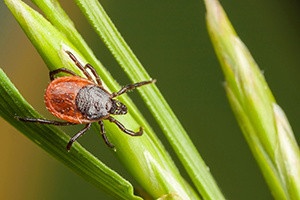 Tragedies involving Lyme disease have become all too common in recent years. And unfortunately Lyme disease is just one of the hazards brought by ticks.
Tragedies involving Lyme disease have become all too common in recent years. And unfortunately Lyme disease is just one of the hazards brought by ticks.
When you’re gearing up to spend a day outdoors you often remember to pack sunscreen to prevent burns and water to stay hydrated, but are you thinking about ticks? Employers with outdoor workers - is your workforce at risk of exposure to ticks? Have you educated them on proper precautions?
For both outdoor workers and individuals simply enjoying some time outside, take time to review these important tick safety considerations:
Who Is At Risk?
You are most likely to come in contact with ticks when you’re in wooded areas, someplace with high grasses, near shrubs, or walking through leaf litter. Ticks prefer moist and humid environments. Generally, ticks are more prevalent from April to October, with the peak being the summer months, but the timing will vary based on the region and climate. It is recommended to use caution throughout the spring and summer months. Click here for a map from the CDC of the geographic distribution of ticks.
What Risk Do Ticks Pose?
Ticks can be infected with bacteria, viruses, or parasites. When an infected tick bites a human, these tick-borne pathogens can be passed to the individual. The most commonly reported tick-borne disease in the US is Lyme disease, though ticks can also carry other illnesses such as babesiosis, ehrlichiosis, Rocky Mountain Spotted Fever, anaplasmosis, Southern Tick-Associated Rash Illness, Tick-Borne Relapsing Fever, and tularemia.
How Can You Prevent Tick Bites?
- Before you go outside, wear clothing to prevent contact with ticks. Suggestions include wearing light colored clothing, long sleeves and pants, and tucking your pants into your socks.
- Long loose hair should be pulled back, braided, or covered.
- Repellant with 20 percent DEET is recommended when you are going to be in an area where you are at risk to tick exposure.
- Treating clothes with permethrin is also advised to further prevent the risk.
- If you are spending time in a wooded area, walk in the center of the path to avoid rubbing against the foliage as much as possible.
- Managing your property to keep deer and mice at bay can also help reduce the risk of ticks.
What To Do Once You Come Inside?
After you come indoors from an area with possible tick exposure, be sure to do a tick check. The CDC suggests the following steps:
- Check your clothing for ticks.Ticks may be carried into the house on clothing. Any ticks that are found should be removed. Tumble dry clothes in a dryer on high heat for 10 minutes to kill ticks on dry clothing after you come indoors. If the clothes are damp, additional time may be needed. If the clothes require washing first, hot water is recommended. Cold and medium temperature water will not kill ticks effectively.
- Shower soon after being outdoors.Showering within two hours of coming indoors has been shown to reduce your risk of getting Lyme disease. Showering may help wash off unattached ticks and it is a good opportunity to do a tick check.
- Check your body for ticks after being outdoors. Conduct a full body check upon return from potentially tick-infested areas, which even includes your backyard. Use a hand-held or full-length mirror to view all parts of your body. Check under the arms, in & around the ears, inside belly button, back of the knees, in & around the hair, between legs, and around the waist.
What If You Find A Tick?
If you happen to find a tick on you, be sure to remove it as soon as possible. To remove, use fine pointed tweezers to grasp the tick as close to the skin as possible. Firmly pull the tick straight out of the skin. Place in a plastic bag or in a jar of alcohol. Never squeeze the tick in between your fingers. Be sure to note the date and size of the bite for future reference. After removal, disinfect the area of the bite, wash your hands, and disinfect the tweezers. Contact your doctor if you have symptoms such as fever/chills, aches and pains, or develop a rash.
Resources
- CDC – Stop Ticks
- NIOSH – Tick-Borne Diseases
- CDC’s geographic distribution of ticks
- University of Rhode Island’s TickEncounter Resource Center
For employers, consider making tick prevention and removal part of your workplace safety efforts. Educate your employees on the dangers of ticks, arm them with the tools to prevent tick bites, and provide them proper training on tick removal.
For individuals, make a concerted effort to pay attention to ticks. Make it common practice in your household that a tick check be done after coming in from the backyard. Those extra couple of minutes can help keep you and your family healthy.




